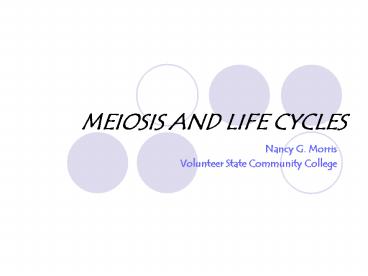MEIOSIS AND LIFE CYCLES - PowerPoint PPT Presentation
1 / 25
Title:
MEIOSIS AND LIFE CYCLES
Description:
The gametes are haploid and 1N. ... The result is 4 1N haploid cells. ... products are haploid 1N. products have a genome different from either parent and each other ... – PowerPoint PPT presentation
Number of Views:99
Avg rating:3.0/5.0
Title: MEIOSIS AND LIFE CYCLES
1
MEIOSIS AND LIFE CYCLES
- Nancy G. Morris
- Volunteer State Community College
2
The Facts
- Meiosis is division for sexual reproduction.
- Meiosis produces sex cells or gametes .
Egg or ova produced by the ovary.
Sperm produced by the testes. - Meiosis reduces the chromosome number by
one-half. - Reduction Division ensures that gametes contain
only one chromosome of each chromosome pair.
3
Meiosis
- Sexual reproduction and meiosis are synonymous.
- Occurs in animals, plants, and other eukaryotes.
- Sexual reproduction improves a species chances of
surviving. Why?
4
Diplontic Life Cycle
- In organisms that exhibit a Diplontic Life Cycle
-- every cell is diploid 2N except the gametes. - The gametes are haploid and 1N.
- Union of the two gametes restores the diploid
condition in the zygote. - 1N 1N 2N
- haploid haploid diploid
5
Diplontic Life Cycle
- 1N egg 1N sperm 2N zygote
- (1 haploid cell) (1 haploid cell)
(1 diploid cell )
6
Diplontic Life Cycle
- Meiosis begins with a diploid cell and involves
two divisions Meiosis I and Meiosis II. - The result is 4 1N haploid cells.
- Each resulting cell, or gamete, has the same
chromosome number, but the chromosomes are not
identical. - This ensures variation and infinite diversity.
7
Diplontic Life Cycle in Humans
8
Human egg and sperm
9
(No Transcript)
10
(No Transcript)
11
Mitosis differs from Meiosis
- MEIOSIS
- two divisions producing four non-identical cells
- products are haploid 1N
- products have a genome different from either
parent and each other - single gene for each trait either maternal (egg)
or paternal (sperm) - synapsis / crossing over
- MITOSIS
- one division producing two identical cells
- products are diploid 2N
- all products have an identical genome
- two genes for each trait (diploid) one maternal
and one paternal - no synapsis or crossing over
12
(No Transcript)
13
Life Cycles
- Diplontic Life Cycle
- Haplontic Life Cycle
- Diplohaplontic Life Cycle or Alternation
of Generation
14
Diplontic Life Cycle
- Diploid adult
- Gametes produced by meiosis
- Diploid zygote
15
Haplontic Life Cycle
- Haploid adult
- Gametes produced through mitosis
- Zygote undergoes meiosis
16
Diplohaplontic Life Cycle
Diplohaplontic Life Cycle or Alternation of
Generations
17
Mitosis Review
18
Mitosis Review
19
Comparison of Meiosis Mitosis
20
(No Transcript)
21
Events of Meiosis
22
Meiosis I
- Synapsis means joining (tetrad)
- Crossing Over occurs during Prophase I
- non-sister chromatids of the tetrad exchange
genes - shuffles the mix of genes within the genome of a
sexually reproducing species
23
Events of Meiosis
24
Asexual Reproduction
- involves a single organism
- involves either mitosis or binary fission
- results in a clone of individuals all genetically
identical to the parent cell - provides no opportunity for diversity or variation
25
Asexual Reproduction
- Budding
- Fission
- Fragmentation
- Cloning
- Multiple Fission































